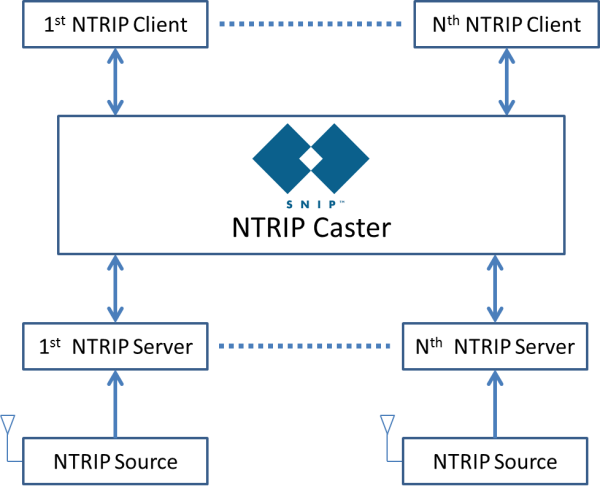“Networked Transport of RTCM via Internet Protocol,” or NTRIP, is…
A protocol developed by the Federal Agency for Cartography and Geodesy of Germany (B.K.G.) around late 2004 that enables streaming of DGPS or RTK correction data via the internet over common TCP/IP methods. Here are some more informal definitions:
- Now that we all have cell phones that support TCP/IP, NTRIP is the preferred way to send DGPS correctional data (RTCM msgs) to your rover without having to set up a bunch of costly local short range radios…
- Now a broadly supported standard (published by RTCM), NTRIP has grown over the past decade to become the most popular method to distribute GNSS corrections of all time…
- The best thing since sliced bread….
The combination of the NTRIP protocol, the open RTCM SC104 messages, and open RINEX file format has served to open up the industry of precise GNSS to a much wider range of practitioners while lowering costs to achieve RTK performance dramatically. Combined with a growing availability of various practical open source GNSS software, RTK navigation with its inherent 100x increase in accuracy is quickly becoming a necessary commodity in many business sectors.
As you read about NTRIP (see the article list below), you will often see variations of the below image used to explain the major component of any NTRIP system. SNIP is an NTRIP Caster, which allows you to set up your own network consisting of the data sources you provide (various NTRIP Servers and other sources) to your end users, the NTRIP Clients. all connecting by use of the internet and local cellular services.
These GNSS clients, making use of the corrections SNIP provides (from the Base Stations), can then achieve the normal ~2 cm accuracy associated with RTK navigation, or with whatever other filters they implement.

More Details…
Each of the elements in the above image, Clients, Servers, and the Caster, is briefly explained in other articles in the SNIP knowledge base.
Here are a few very good summary articles on NTRIP and how it is used to get corrections to the rover devices in the field. Many commercial firms, including those below, provide or sell Client software which works with SNIP or other Casters. [For a partial list of GNSS Client software that works with SNIP, see this article]
From UNAVCO
http://www.unavco.org/search/search.html?q=ntrip#gsc.tab=0&gsc.q=ntrip
From Wikipedia
https://en.wikipedia.org/wiki/Networked_Transport_of_RTCM_via_Internet_Protocol
From Ag Leader
http://www.agleader.com/blog/ntrip-cors-how-it-works-and-what-is-involved/
From NovAtel
http://www.novatel.com/products/firmware-options/firmware/ntrip/
Hint: Interested in the details? The official RTCM standard is a standard which you must purchase (it is available from RTCM), but here is a freely available link to the pre-standardized version maintained by BKG which will likely serve to answer any initial technical questions you may have.
Any list of NTRIP educational materials will omit worthy articles; please send us a note with a suitable link if we have missed a good one so that we can add it.
On Capitalization
NTRIP = Networked Transport of RTCM via Internet Protocol. And this capitalization (all caps) is used almost universally. We suggest you always capitalize these letters. There are a few places when the alternative capitalization of Ntrip is found. The actual RTCM standards document follows this as the original German authors (BKG) used this format. When any NTRIP Clients provide their agent strings, is it also traditional to use all caps. But the current adopted standard does allow an exception (the text states this token is to be considered case insensitive) due one early deployment using mixed case. In the current adopted standard the following three formal terms are defined and used: NtripCaster, NtripClient, and NtripServer. This is motivated in part to better clarify that an NtripCaster device is in fact (mostly) an HTTP Server, while both and NtripClient, and NtripServer devices are in fact HTTP Clients. [Mostly means that while an NTRIP Caster uses the common html verbs GET and POST, but it would be a mistake to presume that an NTRIP Caster follows other html conventions when it in fact does not.]
Need an NTRIP Caster? We suggest you use SNIP.
Need an NTRIP Client? Here is a list of popular software.
